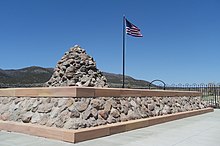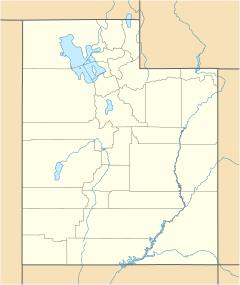| Mountain Meadows Massacre | |
|---|---|
| Part of the Utah War | |
 The 1999 burial site monument | |
| Location | Mountain Meadows, Utah Territory, U.S. |
| Coordinates | 37°28′32″N 113°38′37″W / 37.4755°N 113.6437°W |
| Date | September 7–11, 1857 |
| Target | Members of the Baker–Fancher wagon train |
Attack type | Massacre |
| Weapons | Guns, Bowie knives |
| Deaths | 120–140 members of the Baker–Fancher wagon train[1][a] |
| Perpetrators |
|
| Motive |
|
| Convicted | John D. Lee, leader in the local Mormon community and of the local militia |
The Mountain Meadows Massacre (September 7–11, 1857) was a series of attacks during the Utah War that resulted in the mass murder of at least 120 members of the Baker–Fancher emigrant wagon train.[1][a] The massacre occurred in the southern Utah Territory at Mountain Meadows, and was perpetrated by settlers from the Church of Jesus Christ of Latter-day Saints (LDS Church) involved with the Utah Territorial Militia (officially called the Nauvoo Legion) who recruited and were aided by some Southern Paiute Native Americans.[2] The wagon train, made up mostly of families from Arkansas, was bound for California, traveling on the Old Spanish Trail that passed through the Territory.
After arriving in Salt Lake City, the Baker–Fancher party made their way south along the Mormon Road, eventually stopping to rest at Mountain Meadows. As the party was traveling west there were rumors about the party's behavior towards Mormon settlers and war hysteria towards outsiders was rampant as a result of a military expedition dispatched by President Buchanan, and Territorial Governor Brigham Young's declaration of martial law in response.[3][4][5] While the emigrants were camped at the meadow, local militia leaders, including Isaac C. Haight and John D. Lee, made plans to attack the wagon train. The leaders of the militia, wanting to give the impression of tribal hostilities, persuaded Southern Paiutes to join with a larger party of militiamen disguised as Native Americans in an attack. During the militia's first assault on the wagon train, the emigrants fought back, and a five-day siege ensued. Eventually, fear spread among the militia's leaders that some emigrants had caught sight of the white men, likely discerning the actual identity of a majority of the attackers. As a result, militia commander William H. Dame ordered his forces to kill the emigrants. By this time, the emigrants were running low on water and provisions, and allowed some members of the militia – who approached under a white flag – to enter their camp. The militia members assured the emigrants they were protected, and after handing over their weapons, the emigrants were escorted away from their defensive position. After walking a distance from the camp, the militiamen, with the help of auxiliary forces hiding nearby, attacked the emigrants. The perpetrators killed all the adults and older children in the group, in the end sparing only seventeen young children under the age of seven.[a]
Following the massacre, the perpetrators buried some of the remains but ultimately left most of the bodies exposed to wild animals and the climate. Local families took in the surviving children, with many of the victims' possessions and remaining livestock being auctioned off. Investigations, which were interrupted by the American Civil War, resulted in nine indictments in 1874. Of the men who were indicted, only John D. Lee was tried in a court of law. After two trials in the Utah Territory, Lee was convicted by a jury, sentenced to death, and executed by firing squad on March 23, 1877.
Historians attribute the massacre to a combination of factors, including war hysteria about a possible invasion of Mormon territory and Mormon teachings against outsiders, which were part of the Mormon Reformation period. Scholars debate whether senior leadership in Mormonism, including Brigham Young, directly instigated the massacre or if responsibility for it lay only with the local leaders in southern Utah.
- ^ a b King, Gilbert (February 29, 2012). "The Aftermath of Mountain Meadows". Smithsonian. US Government. Retrieved February 3, 2019.
- ^ "Mountain Meadows Massacre". Archived from the original on September 26, 2022. Retrieved December 31, 2022.
- ^ Shirts (1994), Paragraphs 3, 4, 5, 6 "War hysteria permeated the area. ... Governor Brigham Young subsequently issued a proclamation of martial law".
- ^ Lee (1877), p. 308, [Brigham Young] "CITIZENS OF UTAH: We are invaded by a hostile force, who are evidently assailing us to accomplish our overthrow and destruction.".
- ^ David H. Miller (1972). "The Ives Expedition Revisited: A Prussian's Impressions". The Journal of Arizona History. 13 (1). Arizona Historical Society: 7, 18, 19. JSTOR 41695038.
[7] – outbreak of the Mormon War ... Mormons were already engaged in hostilities with the United States Army forces, [18] – were inciting unrest by intimating that the real purpose of the river expedition was to steal Indian lands ... [19] – Mormon rebels were among the Mohaves inciting them to murder and plunder ... [Thales] Haskell's impressions of his hosts as treacherous Yankees bent on plundering helpless Mormons.
- ^ Bagley 2002, pp. 56, 62–66, 388–389; Briggs 2006, p. 313; King 2012; Brooks 1991, pp. 10, 14, 101–105, 266: The figure of 120 to 140 dead that appears on Page 266, in Appendix XI of Brooks, is taken verbatim from Deputy U.S. Marshal William H. Rogers' Statement, as printed in the February 29, 1860 edition of the Valley Tan newspaper
Cite error: There are <ref group=lower-alpha> tags or {{efn}} templates on this page, but the references will not show without a {{reflist|group=lower-alpha}} template or {{notelist}} template (see the help page).
